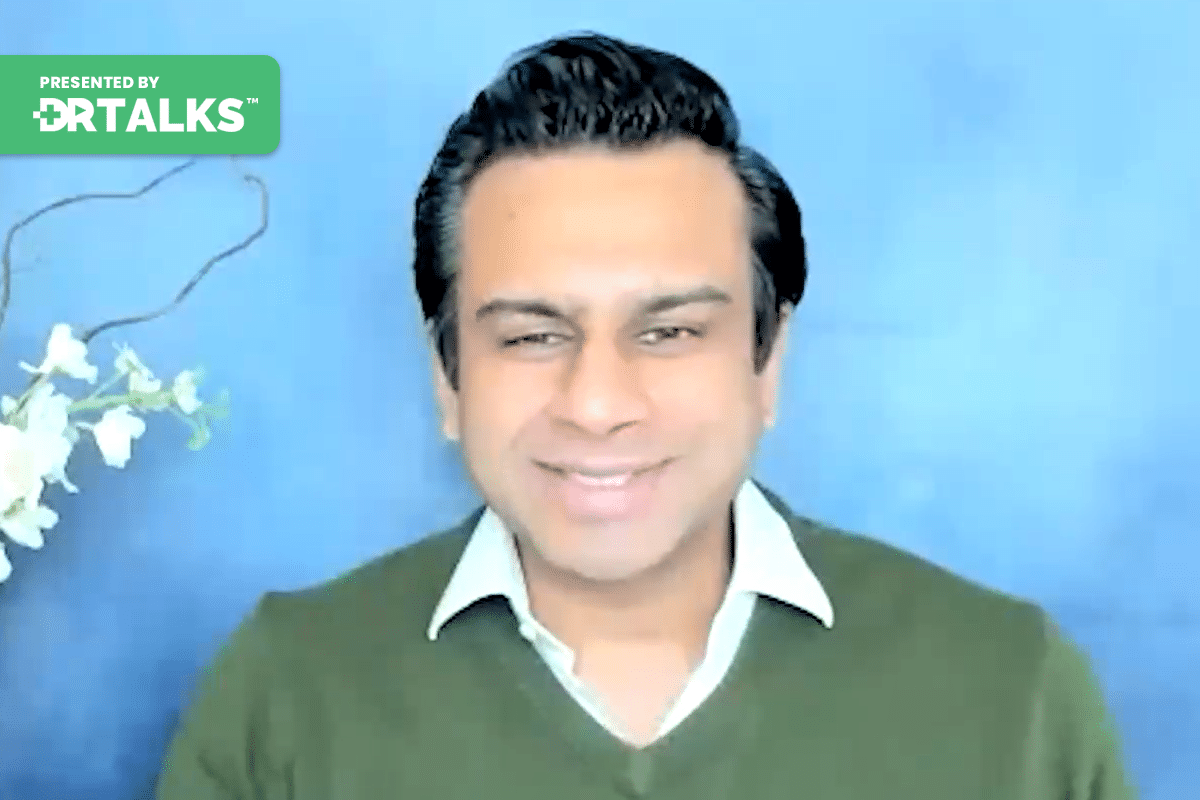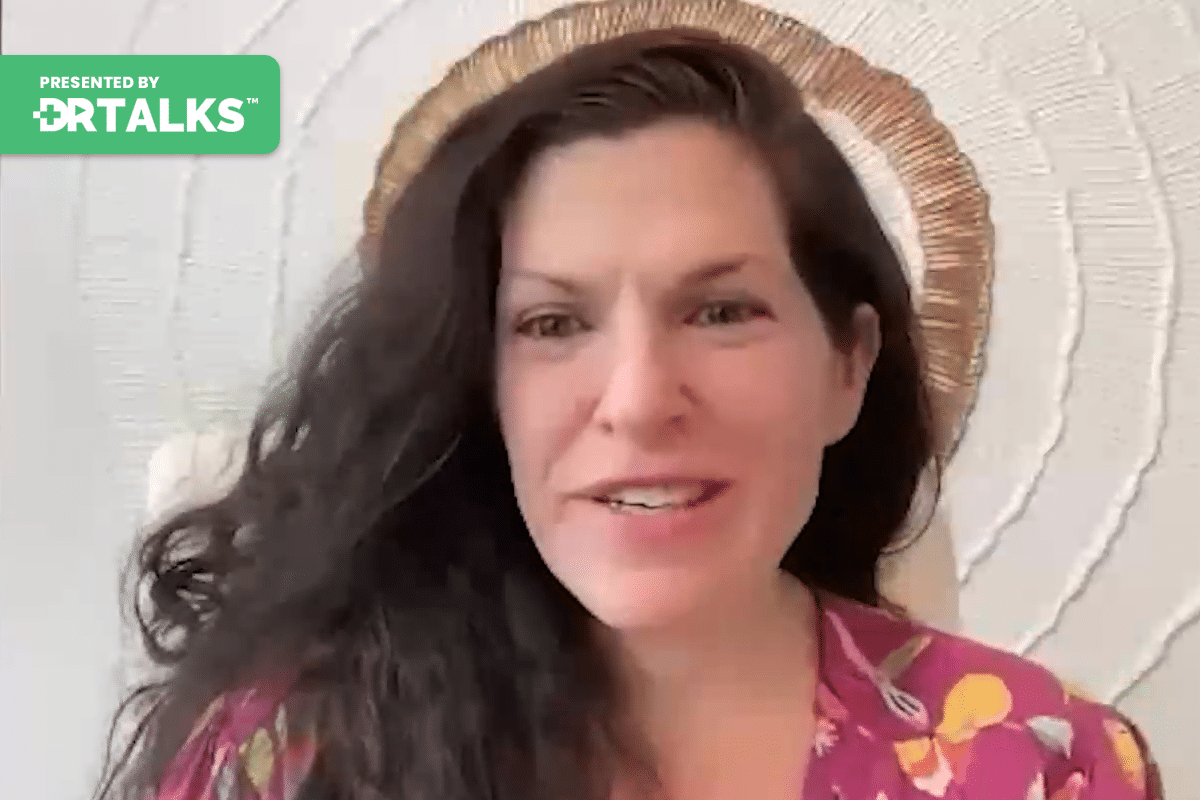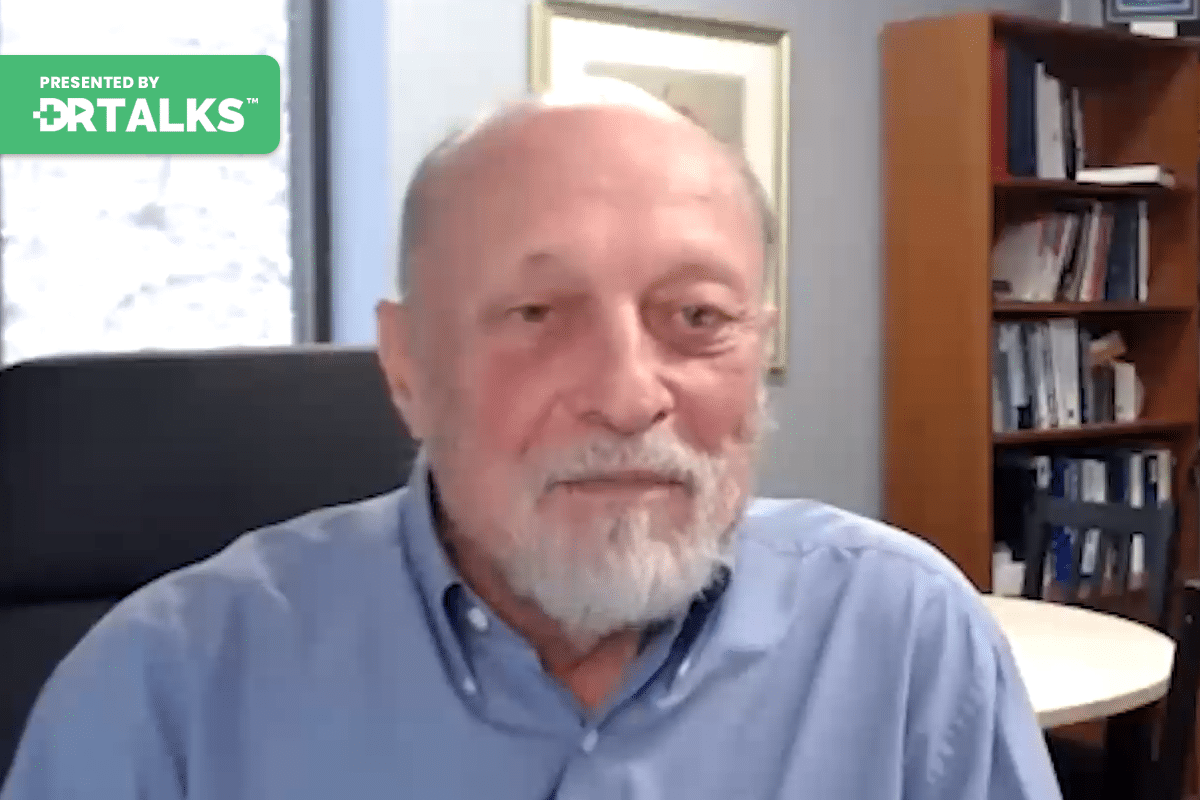Join the discussion below

Dr. Rodger Murphree is a chiropractic physician and board certified nutritional specialist. He is an internationally recognized fibromyalgia expert. His “Murphree Method,” a combination of functional and orthomolecular medicine, has helped thousands of patients get healthy and feel good again. He’s the author of 3 books for patients and doctors including... Read More

Ashok is an internationally renowned Speaker, Filmmaker & Health Practitioner who has dedicated his life to supporting people through chronic illness, and achieving their potential.Ashok suffered from ME, or Chronic Fatigue Syndrome, around 25 years ago when he was studying at Cambridge University. Through neurological research that he conducted, he... Read More
- What is Neuroplasticity
- Why is your neuroplasticity so important for overcoming fibromyalgia?
- What are some steps you can take to overcome your symptoms
Related Topics
Brain, Chronic Illness, Fibromyalgia, Inflammation, Mindset, Neuroplasticity, Pain, TraumaRodger Murphree, DC, CNS
Hi. Welcome. I’m Dr. Rodger Murphree, and I’m the host of the Freedom from Fibromyalgia Summit. And I want to welcome Ash Doc Gupta here. He’s going to be sharing some information about the Gupta program, which I find extremely fascinating and, quite frankly, very refreshing. You’ve heard other speakers on the summit that have talked about cell danger theory and survival paradox, and Ashok is going to really kind of pull it together for. So I’m really excited to hear about your journey, which is quite fascinating to hear what you had to overcome to even get to where you are these days. A lot of people have just kind of given up, but thank you so much for being part of this summit. So delighted to spend some time with you.
Ashok Gupta, MSc
Rodger. It’s a delight to be here with you, and thank you for inviting me as well.
Rodger Murphree, DC, CNS
So once you a little about Ash Scott, he’s a filmmaker, he is a researcher, and he’s spent the last 20 years, close to 20 years. Right. Really formulating this program that he’s put together to help thousands of people around the world. And he’s going to be sharing the some of the research that he has found with fibromyalgia. I think, again, I think it’s just fascinating as to start to pull this stuff together. But before we do that, tell us about your background. How did all of this even start?
Ashok Gupta, MSc
Yeah, so like many of us in this field, we’ve been through our own personal challenges or someone close to us. And so I actually suffered from any chronic fatigue syndrome, as is often known when I was studying as an undergrad at Cambridge University. And I remember that time when I’m a young man, you know, I picked up some kind of viral infection. I thought nothing of it. But suddenly I went back to university and I would open up a book and couldn’t even read the words on the page. And a concentration went down to zero. Many people with fibromyalgia can, you know, empathize with that. And I just suddenly found myself feeling really weak all the time, really exhausted all the time. And to the point at which I just at my worst point had to crawl to the bathroom. That’s how debilitating it was. And I did have pain in my muscles and joints as well. So, you know, there was lots of symptoms that crossover with fibromyalgia that I was experiencing.
And I went from doctor to doctor trying to understand what was going on and they couldn’t give me a diagnosis. And eventually they said, I think we think you’ve got this thing called any or chronic fatigue syndrome. We don’t know what causes it. We don’t have any treatments for it. There’s nothing we can do for it for you. And you may have this for the rest of your life. I mean, you know, almost like a death sentence for your life. It’s like, well, that’s it. That’s there’s nothing that we can do for you. And that’s, you know, and I’m not sure I met so many people who were experiencing something very similar and going through that suffering. And I really wanted to try to understand what was going on. I was going to take no for an answer. And so I made it. It was like a contract with the universe. And I said, If I can figure out what’s happening here, if I can get myself better, I will dedicate the rest of my life to relieving the suffering that thousands of people experience, millions of people experience. And so I started researching brain urology and physiology and I came across the work of Professor Joseph LeDoux in the nineties. So we’re talking this is the midnight mid to late nineties when actually these conditions were even less recognized, you know, than they are now.
And I picked up some fascinating research on two parts of the brain, the amygdala and the insular parts of the brain. And I then put together a hypothesis and in a very ad hoc way, started retraining my brain. I’m going to be very careful here. This wasn’t psychological in the traditional sense of psychological techniques, but brain retrained, brain rewiring techniques and managed to get myself 100% better. And I published my medical hypothesis in the late nineties online and then in the medical journal in 2002, and then set up a clinic to treat other people. So then we refined and refined and refined the techniques. And in 2007, we were the first company to publish a brain retraining program as a DVD program in the good old days of DVD. Then we’ve done further research since then, which we’ll talk about. And now our program is online. And yeah, that’s been my journey and it’s been a really rewarding journey because just like yourself, when you see people who are in such a debilitated state and then you can support them and help them help them get their lives back, there’s nothing better feeling than that in life.
Rodger Murphree, DC, CNS
No, there’s not. And and and people are hearing your story and thinking, oh, yeah, that was me or that is me right now. You know, that. I’ve heard that, you know, in fibromyalgia, they tell you to have to learn to live with it. And of course, you know, you hear that enough times, you start to believe that that’s your only option. And, you know, hopefully here on the summit, you’re learning all sorts of resources and things that you can do to change that paradigm of the idea that you just have to learn to live with it. So I’m going to talk about neuroplasticity. So this is a fascinating theory about, you know, with fibromyalgia. The studies show that oftentimes these individuals have had a very challenging childhood. So it could be an illness that they had as a childhood. It can be that they travel.
They were in a military family, so they moved a lot. It can be it from a dysfunctional household. A lot of, you know, a lot of trauma going on in the house between the parents and siblings. Abuse, unfortunately, runs in the fibromyalgia community, but they get under all this stress at a young age and they lose their plasticity, their ability to rebound the stress. So something comes along as they get older, could be going off to college, could be their first child. It can be they get a divorce, whatever it is, some type of a stressor is the straw that breaks the camel’s back. And they never can rebound. And then they start to develop the symptoms that we associate with, I imagine, and eventually they get the diagnosis. But it all probably started in childhood losing that ability to be able to handle stress. And in your work you talk a lot about neuroplasticity. Can you share some information about that?
Ashok Gupta, MSc
Yes. Wow. This there’s so many things that you’ve picked up on there. So I’ll talk you through a kind of step by step process of how we look at this condition. So, first of all, the idea of neuroplasticity is that, you know, 20 to 30 years ago, we used to believe the brain was fixed. So neuro plastic, when we’re children, will we form our personality and our habits and our likes, dislikes and our physiology. And then pretty much from our late teen years, especially our 20, that is pretty much the brain is fixed, but it can’t be changed. And then in the last 20 years or so, we’ve realized the brain is constantly changing, constantly rewiring itself. Yeah. Which is very empowering because it means that whatever we thought we were or things that we’d like to change are changeable. If we can find the right key, the right lock to unlock mental, physical, emotional health and let’s take that first. So our brains are rewired system is remarkable. And the second thing that the second principle is we are survival machines, so let’s take our evolutionary biology.
So we started off, as you know, we’ve got millions of years of evolution that are programed into our genes. So we started off with plant life, then single celled organisms and invertebrates, vertebrates, reptiles, mammals, human beings. And what I find fascinating, they say that 40 to 50% of our DNA is the same as a banana, which is really interesting. So we got all of that thing here. Yeah, it is. So we have all of that evolutionary adaptation stored in our programing, which means that we can adapt to our environment, survive, and pass on our genes to the next generation. So this nervous system in this brain prioritizes survival over wellness. And this is a clue to fibromyalgia. Survival is more important than wellness. So that’s our second principle. Now let’s come to our third principle.
You’ve talked about the past childhood trauma or our inability to handle stress and bounce back, a lack of resilience. They often call it. Now, what happens is we know that there’s a brain structure called the amygdala, which sits behind the eyes, which is essentially is two of them. There are danger responses. And so we know that if somebody has been through a traumatic childhood in whatever shape or form or a lot of stress, the fact resetting of that amygdala get disrupted and they become the brain becomes more reactive in general to fearful stimuli. And once those fearful stimuli have been triggered in the brain, it breaks it takes it longer for it to calm down and come back to baseline. So that’s what we call that, the lack of resilience. So difficult challenges in second chances happen the brain gets stimulated and then takes a longer time than most people to come back to its normal state. Yeah, and we know that childhood experiences even experiences in the womb, even experience of childbirth, can all impact on that factory setting of the amygdala.
Now let’s say then somebody has some kind of physical injury or some kind of localized pain in the body. Might be back pain, might be wrist pain, some kind of pain in the body. The brain is designed to take in those incoming stimuli, those pain signals process those pain signals. And there are two systems. There’s a stimulating system and an inhibitory system. So the stimulating system says that localized pain is dangerous. So it’s trying to ramp up pain, signaling so that we do something about it. Then there’s an inhibitory system that pulls back on that pain signaling to say, actually, we want to moderate that to the level of threat that it represents. And this is the secret in the neurology. If we’ve had childhoods where our brains are more defensive and more likely to react when not incoming pain signaling comes into the brain, the amygdala, the insula, which is another brain structure I’ll talk about, but let’s just call it the brain for the moment. Those incoming signals get magnified and then they get processed in the brain. But the brain is less likely to ratchet down defense systems because of childhood experiences. So the brain errs on the side of caution because it prioritizes survival.
Survival is more important than your well-being. Then what happens in the brain circuitry? We’re having these pain signals and the brain thinks there’s something wrong. Let me just send out inflammation into the body, which is normally what happens when you have pain. So we know that if you let’s say you have a cut on your arm or a cut on your leg, what happens is the brain detects that and there is signaling to say we need to send inflammation and defensive systems and trigger the immune system around that localized space. But imagine if the brain now, if something goes wrong in the wiring, which is an overreaction. So the brain starts sending global sized inflammation around the body and that causes then a lot of pain around the body, that those signals in the peripheral areas all get ramped up. They come back to a brain that then magnifies those signals in the parallel production. GRAY In the base of the brain, those signals go into the brain.
The brain says, I knew it. I knew we were in danger. Something bad is happening. Let’s err on the side of caution and once again send out tightness. So tightening of the muscles stimulates the nervous system around the body but also lets trigger the immune system as well. Sending globalized immune reactions throughout the body, causing globalized inflammation. Oh, but now those signals come back to our hyper defensive brain and we get caught in the what we call the vicious cycle of chronic illness, where the inputs and outputs of the system have now got linked, like short circuiting a battery. And that’s what then goes on to causing chronic illness. And if I can give an analogy that I think people find really useful here, let’s imagine, Rodger, that you are king, Rodger, of your kingdom. Okay, now, Rodger, are you a Game of Thrones fan by any chance?
Rodger Murphree, DC, CNS
I’ve never watched it.
Ashok Gupta, MSc
I’ve never watched.
Rodger Murphree, DC, CNS
Okay, that’s good.
Ashok Gupta, MSc
I don’t know. But if violence and nudity say, it’s probably not probably a good thing. Basically, let’s take a fairy tale, for instance. So you are King Rodger of you’re king of your castle. And let’s say the army is your nervous system and the Navy is your immune system designed to defend the kingdom and defend the castle. Now, let’s imagine there’s a drought in that kingdom, so the whole kingdom is a little weaker than it would be normally because of the drought. Then an incoming army comes over the hill. That’s something that has caused the injury or the pain. An incoming army comes over the hill. The Army and Navy now defend valiantly your kingdom and they defend it. But they only just managed to defend the kingdom and they fight off the incoming invader, which is whatever caused that inflammation. They come to you. KING Rodger. And they say Rodger. They say. KING Rodger. We need all of the resources of the kingdom now. We need the wheat, the grain, the metals, because the kingdom nearly fell. So you say rightly, yes, we have all the resources. So now the Army and Navy are on hyper defense alert. They’re constantly sending the arrows out, even at the smallest hint of anything coming over the hill. So the child walks over the hill, quick, shoot your arrows, shoot your war machine to defend the kingdom at all costs. So now what’s happening is, yes, your body is hyper defended, the kingdom is hyper defend it, but it’s using up all of the resources, the mental, physical, emotional resources to stay in that hyper defensive state, triggering the hyper the inflammation response around the body, but also tightening the muscles, the cell danger response that you’ve talked about, all of these things now getting fired off.
And that makes us hypersensitive to anything else, which is why people with fibromyalgia often then develop chemical sensitivities or sensitivities or sensitivities to light and sound because the whole system is now centralized and sensitive. And that’s what then the vicious cycle is and brain retraining is you. KING Rodger, bringing in your generals saying, I know that we experienced a real danger when the original army came, but the danger is over now. You can step down, you know, down to DEFCON five or DEFCON one, whichever way, whichever way round it is. We’ve seen the films ratchet down the defense response. We are safe. And that is what brain retraining is doing, is training the Army and the Navy, your nervous system and immune system that you’re no longer in danger and switching off both peripheral and sensitized and central pain sensitization.
Rodger Murphree, DC, CNS
So you just described fibromyalgia because you’re talking about the central sensitization. Pain syndrome basically is you know, it’s the thread that we’ve still a lot of different conditions to where the body cannot turn off this sympathetic nervous system that is overreactive. And what we see in the fibromyalgia community is little things that normally would not bother you loud noises, bright lights, the sun, little things that you would take for granted you and I take for granted for these individuals because they’re on such a hyper alert response mode. It doesn’t take much to really set them off and they stay in this pattern and wired and tired. Yes, they’re totally wire and they’re just exhausted. And they may have one of these days where they’re at a little bit of energy all day and they go out and they overdo it. And that’s that puts them in bed for two or three days or are they exhausted all day? And then they catch their second wind towards bedtime. And they can’t you know, they can’t they can’t go to sleep because now they finally got an hour or so window of opportunity to do something, you know, act activity wise. But but this what you’ve just shared is, you know, with the Game of Thrones or the Navy and the Army and the kingdom is fibromyalgia. It just the body is gets stuck in a pattern. Now, you talk about in one of your podcasts, I think maybe a YouTube video where the cells that are wired together, fire together, and this this idea that when we’re under maybe it’s a connection between a stressful event and pain and now those two things come together. And that’s the response going forward is anytime you get real or imagined stress where you feel danger, now you’re triggering the pain response as well. Mhm.
Ashok Gupta, MSc
Exactly. So it’s those neurons that fire together, wired together and so that can be generalized or specific. So some people just whatever stress happens, it’s what’s triggering the nervous system and the immune system for others we treated in our clinic, they don’t get triggered by daily life, but the moment they sit in front of their laptop and open a spreadsheet, the brain says, I remember last time you did this, you put your body in danger, right? This is now a dangerous experience. Let’s trigger those defensive reactions again so it can be specific or very general to what gets wired together. Yeah, absolutely. And I think what’s really fascinating about the brain neurology of it is in the last 20 or 30 years, we’ve really progressed with brain scans. So before the brain was a black box. So medicine was all about what we can measure in the body, but we have no idea what’s going on in this 9 pound gray, gray matter in the skull. Now we’re opening up and saying, oh, we can see roughly what’s going on. And now we from our research, we’ve put a lot of jigsaw pieces together. The key faculties that we believe are causing fibromyalgia are the insula and the amygdala. So it makes it we always talk about it’s our emotional danger response, but the insula, it sits between the cortex and the limbic system and essentially takes in the incoming data from the body, interprets it and creates appropriate nervous system and immune reactions and a bit of research. Rodger that. I’d love to share with you. I think your listeners will find really fascinating.
We’ve talked about the insula being the base of this for the last 20 years or so. But recent research just last year by Dr. Asim Rose from Israel, what they did was they took a group of mice and they created a trigger that triggered inflammatory bowel disease in these mice. So there was triggering of the immune system. They then measured the electrical signature in the insula part of the brain. Then these threats went back to baseline. They had no longer had IBD irritable bowel. Then they triggered that same electrical signature in the insula, and by doing that, they triggered inflammatory bowel disease without any external trigger. And that’s the first time in modern medicine that we’ve proven that certainly in rats, the insula is where all of our immune reactivity gets stored, ready for the next time. And we believe that in fibromyalgia, the insula is getting so overwhelmed with pain signals it can no longer fulfill its role as moderate in pain signaling and processing it, and creating the appropriate autonomic and immune response. If given up, it now is trigger happy. It’s firing off the immune system, a nervous system continuously, which is causing all of the downstream symptoms. And that, in a nutshell, is what we believe is happening in fibromyalgia.
Rodger Murphree, DC, CNS
You know, so when I am working with a patient, the first thing I look at, is there any underlying anxiety? I always want to see that because their neurotransmitters, you know, from your research with fibromyalgia, they’re low in serotonin, which is of calming the happy hormone. They’re also typically low in dopamine, norepinephrine, sometimes gamma, aminobutyric acid, some of these neurotransmitters. But when I first start working in a patient, the first thing I want to do is calm everything down because of this over-vigilant response of the nervous system, sympathetic nervous system. And so I’ll use nutraceuticals like l-theanine GABA, some of these things that are out there that can five htp, each of which turns into serotonin and that can be incredibly helpful. But what I’ve learned, I’ve learned this the hard way over the last 22 years, specializing in fibromyalgia, is if you don’t give them some tools to help them mental only be able to process this information, to have exercises, to calm everything down, whether it’s meditation or, you know, certain stretches or breathing, you know, reading exercises. If you don’t do that, they’re always vulnerable. Always vulnerable because all it takes is one stressor and it turns everything back on and then they’re right back to where they were. So it’s got to be a combination of, for me, nutraceuticals, balancing those nutritional deficiencies as hormones and then also the mind body connection, getting that right. I mean, if you get those two things lining up that you stand the best chance of helping this person overcome this thing called fibromyalgia.
Ashok Gupta, MSc
Yes, I agree. And the way that we look at this is imagine you’re standing on a bridge and there’s a river below you and you look down in the river and there’s people drowning in the river. So you jump in, you save that person. Then there’s another person to jump in and you save that person and you keep doing that. And then you set up a rescue center next to the bridge and you think, Wow, this is so good with saving all of these people. And that’s really positive and it’s the right thing to do. But nobody’s asking the question, who’s throwing these people into the water upstream, right? Right. So it’s a combination of both. We then go upstream and say, let’s look at the root cause of this, because if we don’t, then whatever we do downstream is always going to be reactive. It’s not going to the root cause of what is. Why is the nervous system creating this response? Why is the pain networks hypervigilant and magnifying pain signaling? Why is that happening? It’s happening for a perfectly logical reason, which is the brain prioritizes survival. It’s gone through a difficult challenge, sensitizing events, and now that’s left a trauma in the brain, which is I must overreact to anything that reminds me of the original event, which was life threatening as far as the brain is concerned. And so if we can train the brain to say we are no longer in danger, these symptoms in your body, these signals that you’re magnifying, do not represent danger. No. And the more the brain gets that message, you won’t get it overnight. It requires repetition, like learning to drive a car. You know, you don’t do it in one lesson. The theory is fine. You have to repeat again and again and again and again until the brain says, okay, I get it, we’re safe. And then it sees the results of that, and then everything calms down pretty quickly. So that’s what we’re doing in fibromyalgia. In our brain retraining is training the brain that we are safe. And these pain signals do not represent ongoing external threats.
Rodger Murphree, DC, CNS
Essentially shock with this training, is it using neuro linguistic programing? NLP Is that part of this training that you use?
Ashok Gupta, MSc
We use a unique seven step process which has been derived from a number of different areas of therapy and coaching. So certainly there’s a bit of NLP in there. There’s definitely a breathing technique, there’s mindful movement, there’s physical movement and there is self coaching, there’s imagination and visualization. The self-talk parts work, there’s a whole plethora of different tools and techniques that have been brought together. So certainly NLP and we reference that as well, some of that is in there as well. But even NLP and these techniques, there are a description of human change. So although they put them under the banner of an opiate, they’re essentially a description of how people change and how things rewire in the brain.
Rodger Murphree, DC, CNS
Yeah, one of the examples you use in one of your YouTube videos is the fact about phantom limb pain. So someone goes, you know, unfortunate they have to have an amputation, maybe from the knee down and to take care of that problem. But then they start complaining to their physician, yeah, you cut my leg off, but I still have pain. I can feel that pain. Well, there’s no leg. That really is an example of the power of this neuroplasticity of the brain not being able to turn itself off.
Ashok Gupta, MSc
Exactly. And this is a great example you’ve brought up about how we want to be very clear that these aren’t it’s not purely it’s not a psychological set of techniques, because you wouldn’t go to someone who’s got phantom limb pains. Oh, it’s just psychological, of course not. This real wiring that is creating that response is real as far as the brain is concerned. And it’s the same. You know, for instance, as we talked about even strokes, stroke victims. Right. There’s something that shifted and the brain needs to relearn and create new connections to have movement in your arm or your leg. So in a similar way, in phantom limb pain, they use all little tricks of the trade, you know, little mirrors they put somewhere to train the brain that this limb no longer exists, etc., etc.. So eventually the brain is wired to say that part of the body no longer exists. I have the neurons for it, but it doesn’t exist physically downstream. I do not need to take in the incoming signaling anymore and process it. And that is the beauty of neuroplasticity is that the brain will acknowledge it if it is taught in the right way. And that’s what we’re just at the cusp of learning how we do that.
Rodger Murphree, DC, CNS
So fascinating. So people want to know more about your program, which I would encourage you to audience to do, because I think this is a paradigm shift for a lot of people. This is, I think, a big piece of the puzzle that people have been missing. Can’t get the pieces to all come together to put the puzzle together. For me, the last couple of years, learning about cell danger, survival, paradox, neuroplasticity, all these things that I have been kind of talking about in a different little bit different way. All the research is coming together and validating the things that we knew, you know, intuitively kind of knew this, this, but now it’s there and you’ve got a program that can really bring it all together. Where do they go to learn more about you and your work?
Ashok Gupta, MSc
Yes. So they can come to our websites, which is tap program dot com. So that’s G you PTA program dot com and that there’s lots of free videos you can sign up for a free trial. There’s no credit card required, watch lots of videos, there’s even some meditations there as well and find out about neuroplasticity and how our program can help and support. And also what’s important for us is that there is science behind this. So you’ll see the clinical trials that we’ve done. And the most exciting one is the recent when we did in 2020 on fibromyalgia, and that particular study was our program and then an equivalent program focusing on relaxation and what we found after eight weeks. So this wasn’t even a long intervention. After eight weeks in the control group, there was a zero impact on IQ scores. So that’s a fibromyalgia questionnaire. But in the active group, there was a 40% drop in the scores.
There was a halving of depression, halving of anxiety, halving of pain, and a doubling of functional capacity, which is incredible and very, very low responses in the control group. And we want to expand on that. That was our old program. So now a new program’s much better. And so we’re looking to do more and more clinical studies to support the effectiveness of this approach. And our program is actually a six month program because we believe that people need longer to really get that final ten or 20% of improvement. And we’re getting people with fibromyalgia better within sometimes 8 to 12 weeks, sometimes 3 to 6 months. It takes a little longer, but they’re definitely getting up to that 70, 18, 90% recovery and the final ten or 20% is rehabilitating yourself back into normal life, which is kind of interesting as well. And this is really exciting for us and we’re doing studies on chronic fatigue syndrome, fibromyalgia and also long COVID. So we see the similar pathways happening not only in pain syndromes and pain conditions, but also in viral conditions and bacterial conditions where the brain can learn to over respond. And I’ve seen COVID 19. That’s what we think is happening in Long-Covid, a similar neurological process. And so there are so many previously incurable conditions that we’re beginning to have impact on. So even Alzheimer’s people are using now for Alzheimer’s and M.S. So yeah. So if people were to find out more, they can come to our website, watch lots of free videos and see if this is the right approach for them.
Rodger Murphree, DC, CNS
Thank you so much. This has been really interesting. I learned a few things today, and I really think that this science is where we’re heading. You know, I really think this is, you know, a medicine that you’ve been doing this for 20 something years. And oftentimes it takes a while before the 100th monkey or before you finally get to that point. We’re finding people will acknowledge this thing is real. I mean, typically, the medicine may take 20 years before the science becomes mainstream, but your work and others that are here on the summit is making that gap close a lot quicker. And I really believe this. You know, this is where we’re heading. So fascinating research when I encourage everybody check out your website and Ashok, thank you so much for being part of this summit. This is very refreshing and very enlightening.
Ashok Gupta, MSc
Thank you so much. It’s been a pleasure.
Downloads










